Value disciplines in the development of the agency
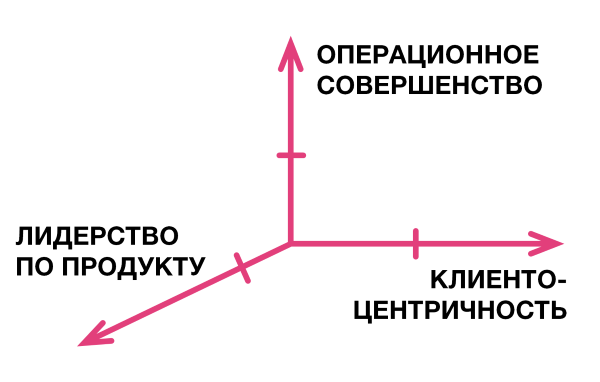 Agencies, web-studios, optimizers and other companies of the Internet services market more often think about the positioning of a company than a year or two ago. The process of searching and forming positioning is “multi-faceted”, it can be approached from different angles and searched for insights from different points of view. Working with clients of the Ruward group of projects (agencies and studios), we often use the Tracy and Wyrsea value disciplines approach.
Agencies, web-studios, optimizers and other companies of the Internet services market more often think about the positioning of a company than a year or two ago. The process of searching and forming positioning is “multi-faceted”, it can be approached from different angles and searched for insights from different points of view. Working with clients of the Ruward group of projects (agencies and studios), we often use the Tracy and Wyrsea value disciplines approach.Previously, we wrote about the rake of agency positioning and the development paths of web studios . The approach of “value disciplines” offers a similar view of the agency’s position on the market in three-dimensional space. He was proposed in 1993 by Michael Tracy and Fred Virsema, who refined Porter's classic basic models (price leadership, differentiation, and focus strategy).
Fair value
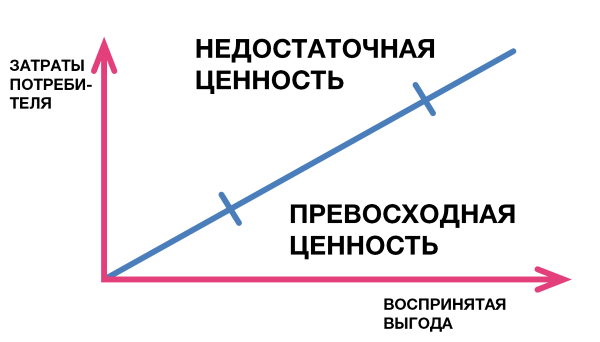
Any client of the agency incurs costs in the project, and different employees - different costs. The decision maker spends budget and time, the project manager on the customer’s side - time and effort. The client also receives some benefits: a working project with good KPIs, promotion, points in the corporate struggle. It is important that the client often perceives the benefit, and does not measure it. For example, when the promo site liked the general, but the exhaust from the advertising campaign was close to zero.
')
When a perceived benefit exceeds costs, it is possible to speak of excellent value for the client, otherwise, of insufficient value . Consider any market segment, for example, on the service: website promotion, SMM campaign, and so on. Among his clients, a certain average idea of fair value is gradually forming: how much a certain quality service should have with certain results. The more developed a segment (for example, web production), the better the idea of fair value is formed among clients.
Three value disciplines
Tracy and Virsema proposed three "value disciplines" - the axes by which one can assess the company's position in the market:
- Product Leadership,
- Operational excellence
- Client centricity.

Product leadership in the case of the agency market - providing the highest quality services (whatever that means) or unique services. “We can make the most technologically advanced high-load site,” or “We have the coolest UI / UX”, or “Each of our viral videos gains at least X views.” Focus on innovation and R & D. A typical example from big business is Apple and Johnson & Johnson .
In the Russian market, Red Keds can be attributed to such companies , which demonstrate “top-notch creativity” and confirm this with stories about their creative techniques and organization of the creative process, as well as with an ICR training program.
Another example, which has become obscene, is “Art. Lebedev Studio” . No, not because “long, expensive, about% ^ € #but”. Because when everyone tried to make “sites like Tyoma’s”, Tyoma was doing industrial design. And when everyone started to do “industrial design, like Tyoma's”, Tyom started city navigation.
Operational excellence - providing services with maximum margins and minimum transaction costs. Often this means an increase in sales, the unification of a product or service, the introduction of operational and financial management systems. Focus on production and delivery efficiency. A typical example of a big business is Walmart and Dell .
For companies seeking to achieve operational excellence, we can include almost all major SEO optimizers: Kokos , Demis , and so on. They typify and automate their services: from audits and sales to production. Another example is “pipelined” web productions such as Reaspect of the 2012 sample or WebCanape . They keep (or have kept) a relatively low development cost, simplifying the chain of sales and agreeing on intermediate results.
Client centricity - the provision of services that are most adapted to each client. It's not just "We solve your business problems." The manager of the customer-centric company is able to understand that the project’s task is to increase the size of the “golden parachute” of the decision maker after the presentation of the advertising campaign before the board of directors, and this is exactly the task. Focus on maximum satisfaction of all project participants, and not the “business” as such. A typical example of a big business is Nordstrom and HomeDepot .
Surprisingly, we could not recall examples of truly customer-centric agencies that would convincingly state this in the market. Know these - write in the comments.
For each of the three axes described, the company may be close to zero, and may have relatively high rates. At the same time, high rates on one of the axes are likely to underestimate the figures on the other two. The “operational excellence” company cannot be very customer-centric, since customer-centricity increases production costs by increasing the management’s share of project costs. A company with “product leadership” cannot be as “operationally perfect” as possible, since it has high R & D costs and its own developments, and also offers fairly high prices for its services.
Whatever we take the market segment, it has some customer perception of fair value in each of the three disciplines. “Fair service” from the client’s point of view has a certain quality of service and end product (“product leadership”), closing a project within a certain time frame at a certain cost with certain management costs (“operational excellence”), and sufficiently responds to unique requests client ("customer centricity"). This fair value for each of the axles is noted in the illustration above.
It is important to remember that fair value may differ in different market segments. She is one among the customers of sites for 30,000 rubles, the other among brand managers of multinational companies and completely different among government customers.
Agency development strategy
- Suppose you have conducted a preparatory analytical work and found out:
- Target market segment for your agency (range of services, pricing, niche in the client industry);
- Representations of fair value regarding “product leadership”, “operational excellence” and “customer centricity”;
- Your competitors' position regarding fair value in these three dimensions;
- Own current positions that look like the illustration.
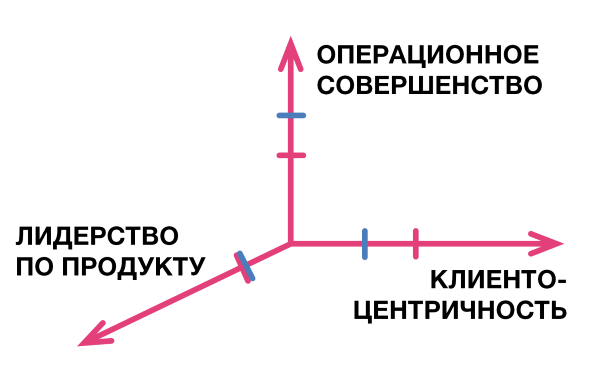
In other words, you offer a service of approximately mid-market content and quality, but you meet the deadlines above the client’s expectations, offer a very competitive cost of services and more competently than competitors manage projects. Unfortunately, at the same time, you have to deny customers the opportunity to "play with fonts" or consider five options for a creative concept.
Most likely, you will choose the strategy of strengthening the strongest side (“operational excellence”) and the positioning associated with it.
Tracy and Wirsema say that to develop on all three axes at the same time is impossible. As we said above, the three disciplines are interconnected and in some aspects compete. You can imagine that the company's positions along the three axes are “tied with an elastic band,” and as soon as you drag up the mark on one of the axes, it “pulls” the other two down.
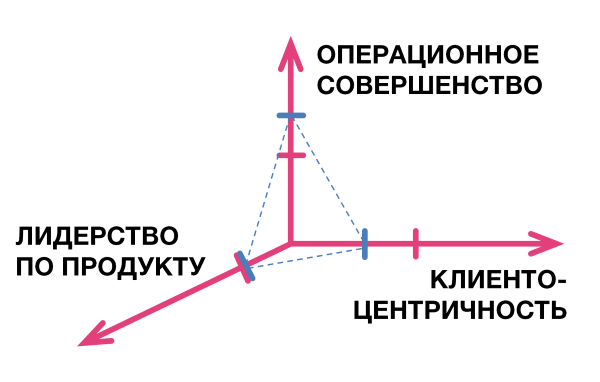
Therefore, the most effective strategy involves the selection of one key discipline in which you intend to surpass the market. This is usually the strongest discipline at the moment. In our example, operational excellence.
The short-term strategy (for the year) should provide for “reaching out” to a fair value along the two lagging axes while maximizing the strength, despite the development of lagging axes will pull down the strong position.
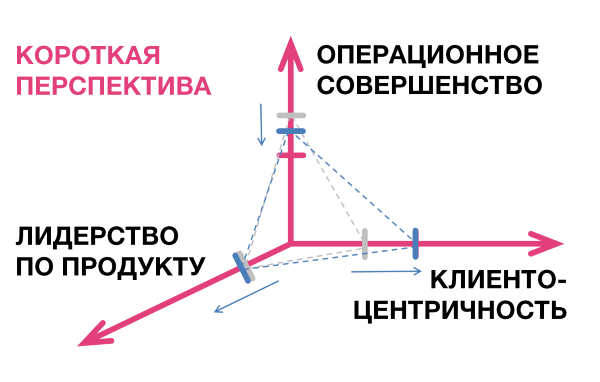
A long-term strategy (for three years) implies the preservation of fair value in two minor disciplines, and building up positions in a strong discipline.

Yes, these are abstract constructions: the market is constantly changing, including fragmented segments, new niches are emerging, the client’s perception of fair value is changing. However, the approach of value disciplines is useful for looking at your own strategy and positioning “from a bird's-eye view”.
Some Guaranteed Misconceptions
1. You may decide that “customer centricity” is a synonym for “customer focus”, therefore the only correct approach for an agency or web studio is customer centricity. This is not true. Many agencies and manufacturers, including those working with large brands, are typical “product leaders.” HungryBoys , Freeger , Deluxe , a lot of them.
2. You can decide that the right strategy is to pump a strong axis right away. This is not true. You will have a relatively low NPS market, because customers will receive less value on the other two axes. It is more reasonable to position itself with an emphasis on a strong axis, “pulling up” weaknesses in the short term.
3. You can decide that the right way is to become leaders in two axes at once. Please write to us as soon as you succeed. This will surely be the first case in the Russian market.
4. You can decide that you can choose different leading axes for different products or services (“product leadership” for creative and web development and “operational excellence” for display advertising, tech support, or SEO). Most likely, it will not work, because the development of any of the axes pulls the change in processes, sales, personnel management, planning and reporting, up to the leadership with which schizophrenia will happen.
Related Links
- Tracy, Wirsema, "Marketing leading companies"
- Value Disciplines (Treacy and Wiersema)
- Customer Intimacy and Other Value Disciplines
- Mitya Voskresensky on management, creativity and knowledge
The article was prepared on the basis of materials from the section “Management, marketing and sales in a digital agency: In Search of the Holy Grail” , organized by Ruward at the conference “RIF + CIB '2014”.
Source: https://habr.com/ru/post/285914/
All Articles